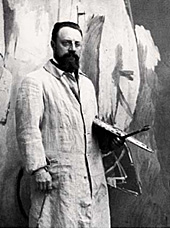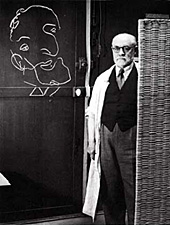“What I am after, above all, is expression… that state of condensation of sensations which constitutes a picture … Expression, for me, does not reside in passion burning from a human face or manifested by violent movement. The entire arrangement of my picture is expressive: the place occupied by the figures, the empty spaces around them, the proportions, all that has its share.”
– Henri Matisse, NOTES OF A PAINTER, 1908
KERA: Matisse once wrote, “What I dream of is an art of purity and serenity, devoid of troubling or depressing subject matter… a soothing, calming influence on the mind, something like a good armchair that provides relaxation from fatigue.”

Henri Matisse in his studio at Issy-les-Moulineaux, 1913 (© CORBIS/Hulton-Deutsch Collection)
Rick Brettell: It’s not that Matisse’s paintings actually were like armchairs, but the fact that he wanted them initially to be attractive and easy– full of, you know, naked ladies and printed fabrics and soft things, and fresh pineapples and wonderful fruits — things that bring you into the work of art. And then you realize how profoundly strange this, at least superficially “easy,” work of art is.At the time he wrote this, Matisse was criticized by people who found this kind of statement hopelessly reactionary. What do you make of it?
It’s an idea of art in which, if you make a work of art that is at least initially and superficially comfortable, then that work of art can more easily enter into the psyche of the modern person. Because the modern person has, as we all know, very little time, has a lot of competing interests pulling at them at every moment, and often wants more than anything else to escape. And if the work of art can provide the occasion for that escape, then no matter how tough or profound that work of art might eventually be, it will be more successful, as opposed to the work of art that simply shocks and turns the viewer away. And that’s the beauty of Matisse’s idea.
Yve-Alain Bois: Picasso often mocked Matisse for making that statement, but Picasso knew what Matisse meant, and he knew that Matisse didn’t mean that art should be “easy.”
KERA: Yves-Alain, you’ve pointed out that it’s hard for a viewer’s eye to rest for very long anywhere in a Matisse composition. Why do you think he adopted that artistic strategy?
Yve-Alain Bois: Matisse once told some journalists that when he was painting a still life of oysters, he had to have new oysters opened every two or three hours. Why? Because he needed to have that special smell, that wetness…
Matisse’s goal was not to represent the thing, but to represent the effect of the thing on him when he was painting it, and to create the same effect on the beholder. In order to do that, Matisse had to attack the senses in all kinds of ways. He wanted to achieve a diffusion of the beholder’s senses, a diffusion of the gaze.
KERA: So how did he achieve that?
Yve-Alain Bois: In different, sometimes contradictory ways. His lines, for instance. Your eye tends to follow multiple lines. With a lot of curves, your eye doesn’t know which way to go. If you present the eye with too much visual stimulation, it simply can’t concentrate.
Matisse didn’t only use the technique of profusion. He used its opposite: bareness. One of his methods of dispersing the gaze of the beholder is to place key parts of the canvas at the extremities of the painting and nothing at the center. Your eye wanders without having a place to rest. What was important for him was to prevent your eye from resting in the center.

Henri Matisse with a chalk drawing he made while blindfolded (© Brassa)
Rick Brettell: Almost anybody who knows about color and its own languages, the emotional and visual languages of color, would give the edge to Matisse, because Matisse makes color do things beyond description.
Yve-Alain Bois: Matisse painted very often using black, but not at all as a color of darkness… black was like any other color for Matisse, something to be used in a play of highlighted contrasts….For Matisse, color never had any symbolic sense. You could never say, you know, “white is purity, black is death, red is blood.” Absolutely not.
KERA: How do you think Matisse felt about his work?
Rick Brettell: Both Matisse and Picasso painted very fluidly and with ease, but Matisse tended to be more often dissatisfied with his part.
Yve-Alain Bois: He was very, very anxious…he always felt that no matter what, he had to take a lot of risks in his art, and he did. He really conceived of the art of painting and of sculpting as a kind of struggle.
At the end of his life, Matisse would paint something and then he would be dissatisfied at the end of the working day, so he would erase everything and he would repaint it, and then he would erase again. Sometimes he would paint and erase the same painting 30 times, until he would get it almost automatically – until his hands could paint without having to think, and then that’s when he thought the painting was perfect, fresh.
He liked the notion, the metaphor of the painter as an acrobat. And Matisse thought – I don’t know if this is true – that high-wire acrobats fall if they think about it, if they think about what they are doing. That the only way they can really do what they do is because they’re so well trained they don’t have to think about it.
He worked enormously hard to achieve a kind of looseness. It was hard for him to be relaxed. And when he finally did, at the end of his life, it was extraordinary. So, taking risks was something that he understood as almost a kind of ethos– that was what an artist did, if one was going to be a great artist.

